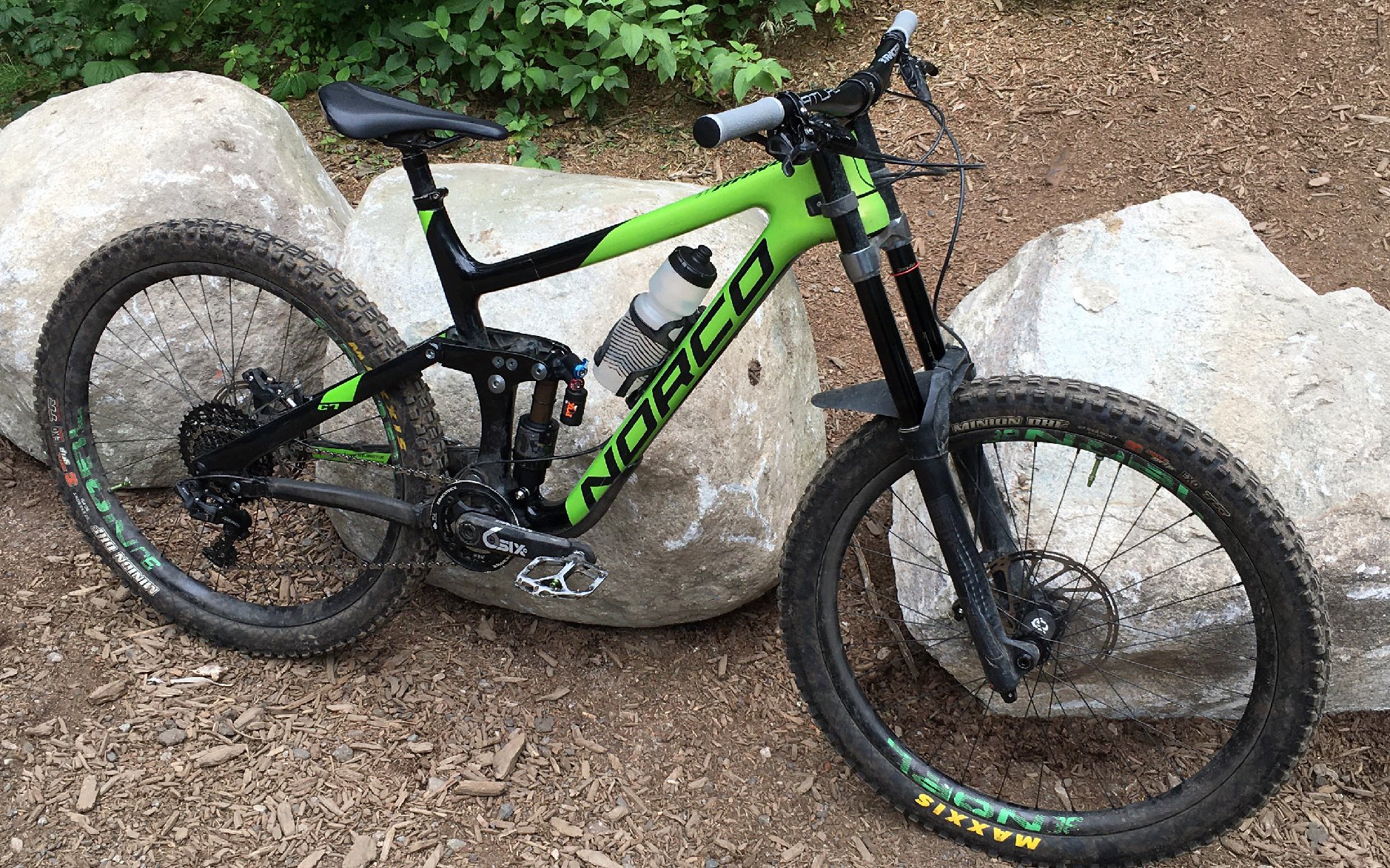
EDITORIAL
My Year as the BoXXer Trail Bike Guy
The Quandary (the Curmudgeon)
All of mountain biking is fun, but I’ll be the first to admit it: I live for the downs. I’m a recovering DH-racer-turned-trail-bike-rider, and gravity is my friend. Don’t get me wrong - I like the satisfaction of earning my turns just as much as the next guy, but I won’t lie to you and say that I have recurring dreams about idyllic 2000m climbs. And I’m willing to bet that most of you reading this right now fall somewhere on the “bikes-are-most-fun-when-coasting-downhill” spectrum.
I’ve owned considerably more dual crown forks than single crowns in my many years of mountain biking and I’ve always harboured a deep mistrust of single crown forks, particularly the long-travel variety. My imaginary engineering background has always told me they are the wrong tools for the job. And dentists are expensive. I gave up on barspins and tailwhips long ago, and my days of thinking X-ups are cool are long gone. Hell, even my daughter’s first run bike had a dual crown.
I was late to the trail bike party. For so many years, my only mountain bikes were full-blown DH rigs. That changed in 2015 when I picked up my first modern trail bike. I made peace with the single crown. Unfortunately, there was nothing peaceful about that little Pike. Creaking CSUs immediately became the bane of my life. Not to mention the vague, “almost-steering” I experienced from long-legged, glorified XC forks. Validation! I was right all along!
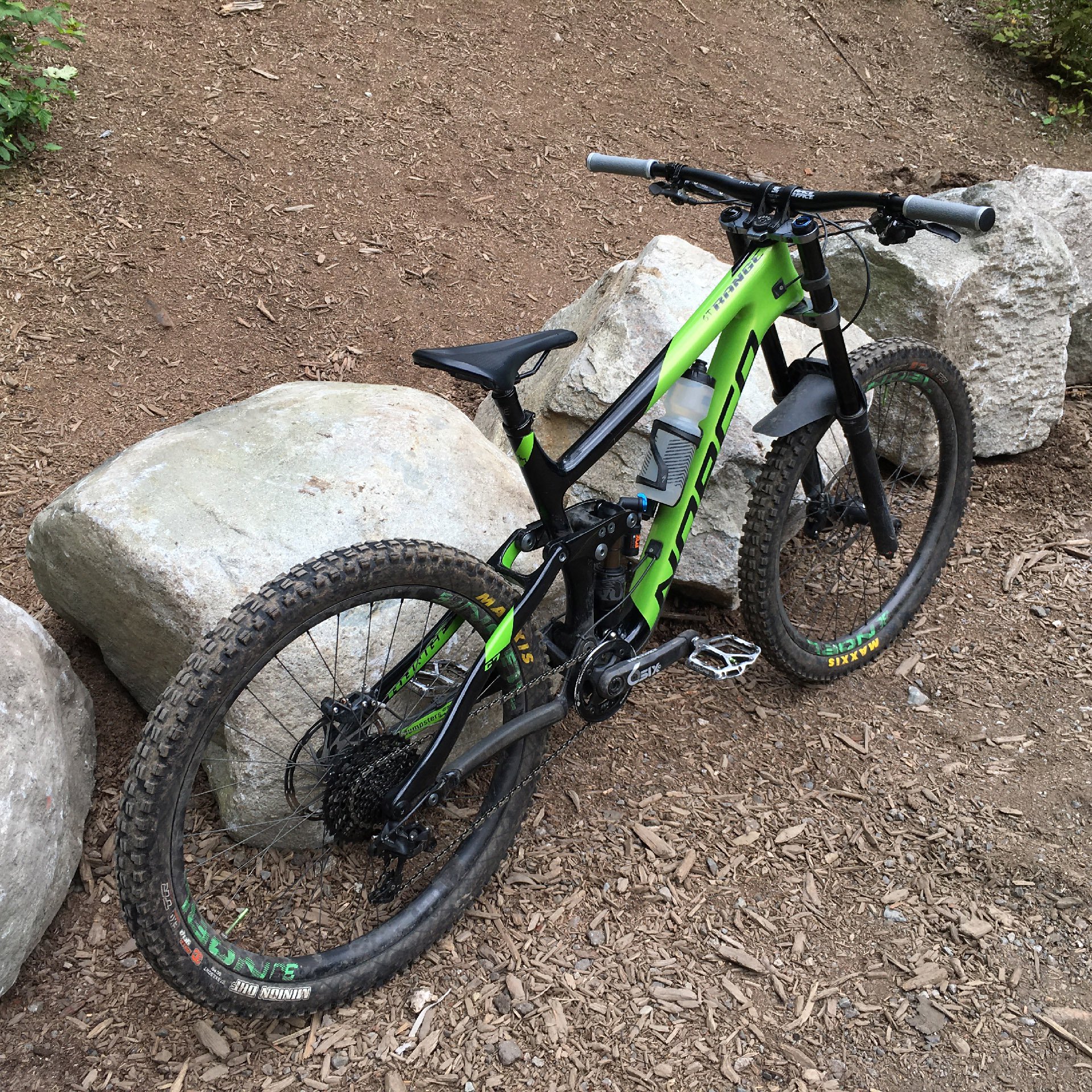
The Solution (Desperation)
Last year, I decided to take a break from single crowns. After some hasty research, I decided that a RockShox Boxxer was going to find its way onto my 650b Norco Range. The Boxxer was the obvious choice for a cheapskate like me, as you could readily find dozens of them being flogged for a song on the buy n’ sells. People basically give these forks away because the stanchions are the wrong colour or something. Also important was the fact that BoXXer travel could easily be adjusted down to 180mm with a simple and inexpensive air spring swap. Because a trail bike with a dual crown is pretty neat, but a trail bike with 200mm travel is lunacy.
So, after throwing a bunch of celebratory X-ups, I swapped out my creaking Lyrik (RIP) for a Boxxer RC. That was the day I became the Boxxer-trail-bike-guy.
Rebound was set somewhere between 'very fast turtle' and 'medium speed bunny'
There were zero issues geometry-wise going from a 180mm Lyrik to a 180mm Boxxer. The axle-to-crown lengths were basically identical (with the Boxxer coming in 1mm shorter on paper). Fork offset went from 42mm on the Lyrik to 46mm on the Boxxer. Pushing the front wheel out a bit would give me more stability and confidence on steep, fast and otherwise fun trails. The trade-off of course was less snappy handling on those idyllic 2000m climbs that I never dream about. It was a compromise I was willing to make.
I ran into my first issue before I even had a chance to ride the bike: “Holy smokes, my bike doesn’t fit on my NSR rack anymore”. My initial research neglected to uncover the fact that even though trail bikes and DH bikes often share the same headset standards - trail bikes tend to have more bulbous lower headtube cross sections. This is generally done by frame manufacturers to reinforce the headtube/crown interface that sees so much stress during heavy-duty riding. DH bikes don’t need as much material here, as they distribute the fork forces more evenly across the entire headtube by way of their big, beautiful, dual crowns. The combination of oversized headtube and upper stanchions made for some interference when trying to load the bike on the NSR-4 cradle. After a bit of rack “tweaking” (thanks to the fine folks at North Shore Racks for helping me out with this), it was time to hit the trails.
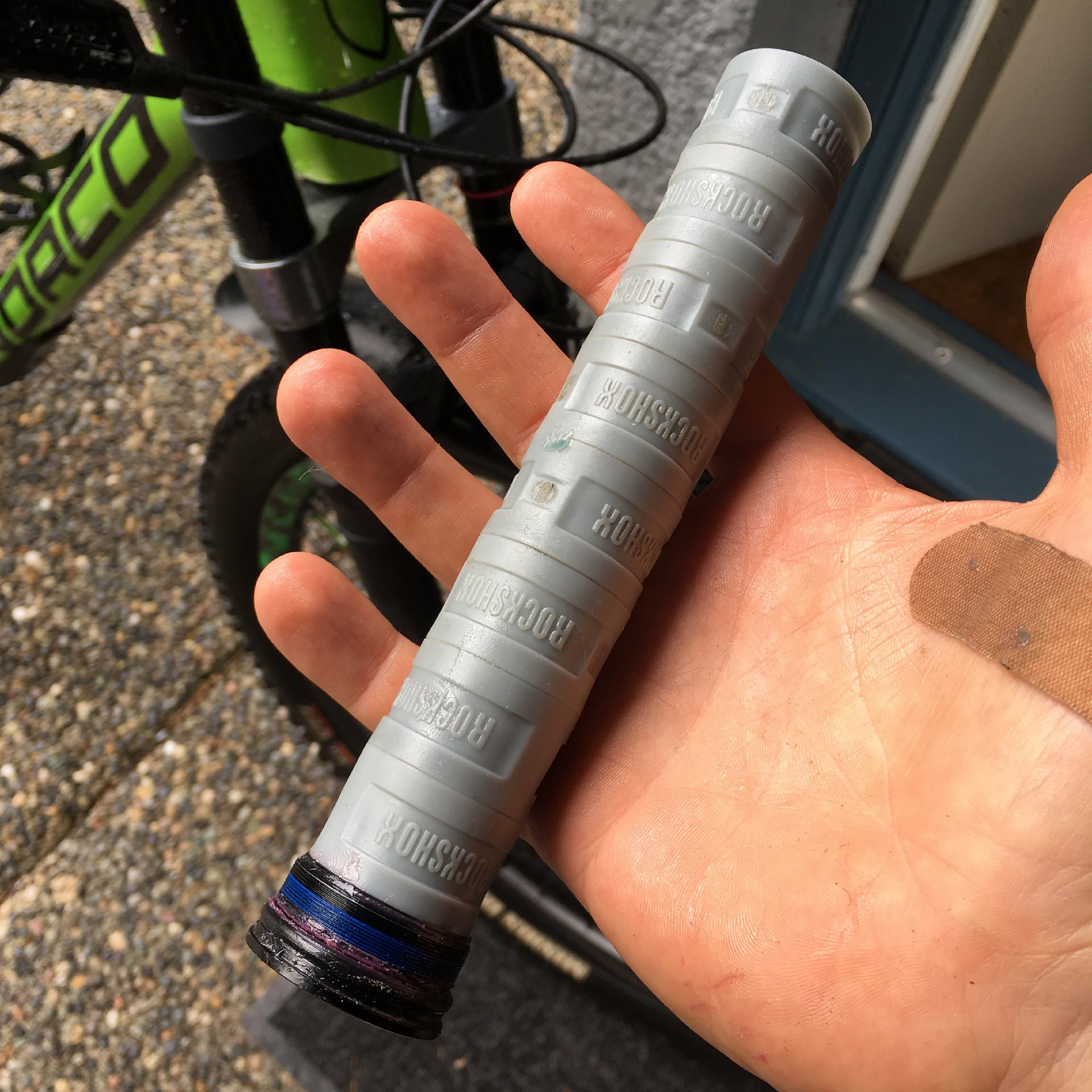
You might call Ryan a progressive rider.
The first thing I noticed while riding in anger was - you guessed it - the stiffness. I didn’t notice the sounds of a flaming dump truck filled with roman candles coming from my fork crowns, mainly because there weren't any. Instead, I was treated to the wheezing of the stock RC damper in the Boxxer. A few weeks in, the RC said adios while negotiating a questionable line choice down a wall of boulders. To be fair, it was a heinous hit and I wasn’t too surprised at the blown damper. But it was a good excuse to stick the far superior Charger 2.1 in there.
Back to the stiffness. There was lots of it. With the increased bushing overlap of 180mm travel, along with NOBL TR38 wheels and Race Face Atlas everything - the front end of this bike likely rivalled any DH bike in terms of stiffness. It was a sensation that took some getting used to. When you turned those handlebars - by god, you’d better believe the front wheel was going to follow. And if you made a mistake, there was no flexy noodle up front to temper your bad decisions. It made me realize just how “delayed” the steering of a single crown could be. This became even more apparent in the bike park. Spoiler alert: When riding at DH race speeds, a DH fork is far more confident at picking lines and staying on them. This new sense of hyper-control was addictive, and borderline uncomfortable for a trail bike. This setup isn’t for everybody. I don’t even know if it’s necessarily better. There is such a thing as too stiff, and I was definitely flirting with that realm. But I had a silent front end that went exactly where I told it to. Mission accomplished.
Let’s talk about air springs. I like them because they’re light and adjustable. The Boxxer is a DH fork, optimally designed around 200mm of travel encountering high speeds and hard impacts. I knew that getting it to feel right for trail bike duty was going to be a challenge. I also happen to like my suspension more progressive than Bernie Sanders on an ayahuasca trip, so after much experimentation, I found my sweet spot at 122psi and a quantity of tokens that was more than zero, but less than ten. The fork was supple enough to handle low intensity trail noise, but ramped up considerably to resist all but the most violent bottom-out events. As far as damper settings go, I was running somewhere in the middle on LSC, and found that 2 clicks of HSC was ideal. Rebound was set somewhere between “very fast turtle” and “medium speed bunny.” For the record, I’m in the neighbourhood of 195lbs fully geared up, and would describe my riding style as “fast enough to regularly break bike parts, but slow enough to still pay for all of them.”
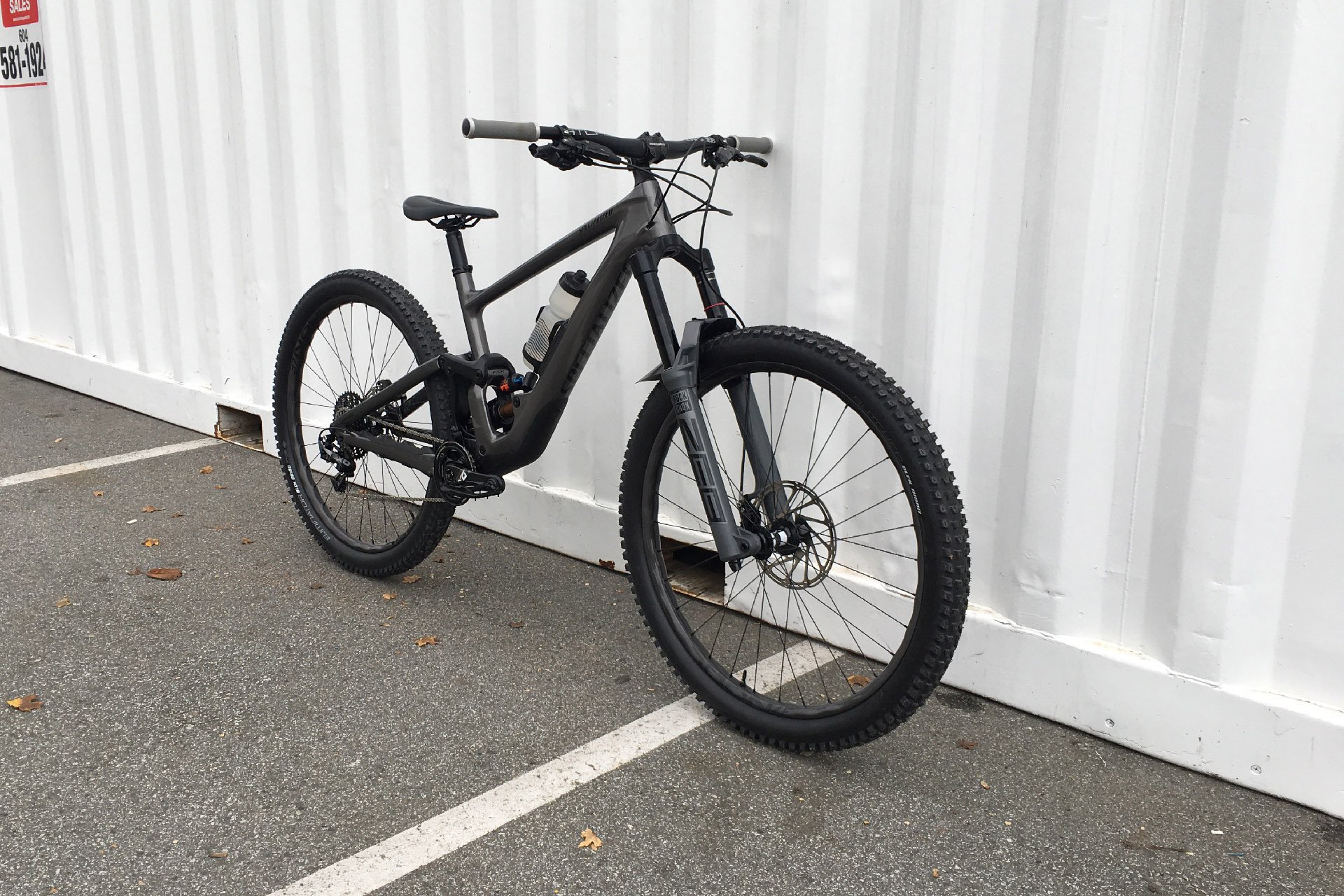
Out with the old... Ryan's brand new Specialized Enduro 29 with a RockShox Zeb on the front (and lots of tokens).
While out riding, I often got asked why I was pedalling around on an Aurum. After politely pointing out that it was in fact a Range, that’s when the real questions came - like: “Oh, how is the turning radius?” This is a fair question, and one that was only to be answered by riding the bike in lots of different situations. After a full year of trail riding with the Boxxer, the only times I encountered the fork stops was while negotiating tight climbing switchbacks. Ironically, the bump stops sometimes aided in getting me around those corners, as I found I could “lean” against them while making the turn. This proved helpful when I was truly gassed - as long as I set up wide for the corner, I could turn the bar, rest on the bump stop for a split second and be on my way. I was happy to have traded in X-ups for that little trick.
I was also frequently asked about the weight. I don’t have exact numbers, but at one point I determined that I had gained less than a pound on the bike. SRAM claims a difference of about 560g between the current Lyrik and Boxxer. Keep in mind that comparison is for a 150mm Lyrik, and doesn’t account for the lighter (shorter) steerer and lighter DM stem you get to use with the Boxxer.
The About-Face (marketing always wins)
Sadly, my time as the Boxxer-trail-bike-guy recently came to an end quicker than I expected. I’m almost ashamed to admit that I drank the kool-aid and got into the 29er game. It’s a wacky game and I’m still trying to figure out the rules. My entry fee included a Zeb that was chosen because I liked the colour. The first rules I learned about the 29er game is that wheelbase is now measured in postal codes, and colour coordination is of paramount importance. I’ve been on the Zeb for about a month now, and I’m trying to stay cautiously optimistic about losing that upper crown.
How is the Zeb? Perhaps my frame of reference is a bit skewed coming from the Boxxer. As it’s an entirely new bike, it’s almost comparing apples to oranges anyway. In my experience so far on the steeps and deeps of the Shore, the Zeb feels almost as precise as the Boxxer did. It would be hard to tell them apart in a blindfolded, back-to-back comparison - but I wouldn’t recommend riding either of these forks while blindfolded. I’m willing to bet that the difference would be more apparent in the bike park, at truly high speeds. Worth noting is that the 38mm stanchions result in an air spring head with a larger surface area, which translates to much lower pressures in the Zeb. I’ve found that this makes the fork sensitive to slight variations in pressure - a few PSI in either direction can have a very noticeable impact on fork performance. If you go Zeb, make sure you have a high quality (preferably digital) shock pump. On my 170mm Zeb Ultimate 29, I seem to have settled at 72psi, ALL THE TOKENS*, and 1 click of HSC. And the answer to the zillion dollar question: my Zeb is not creaking. Yet. And I’m still not doing X-ups. Yet.
*(4 tokens - the maximum)
A quick side note about Zeb: Right out of the box, mine felt a bit harsh in the initial stroke. This was a bit surprising considering the “war on friction” marketing schtick that SRAM has heaped on us recently. That said, it does feel like the fork is “breaking in” and getting smoother every ride. Maybe all that increased bushing surface area just needs a bit of action to settle into optimal parameters. I’m curious if other Zeb owners have found this as well…
Quasi-Conclusion (to be continued?)
Would I do the dual crown again? Absolutely. My experience running a dual crown was overwhelmingly positive, and I still suspect that we may see “mini” dual crowns from the big players in the near future. It didn’t take long for reports of creaking 38s and Zebs to surface (knocks on all things made of wood), so where else can we go from here? Please, for the love of god don’t say 40mm single crown stanchions - in my head, this will always translate directly to: “Hey! Here’s a fork with dirt on the inside, and all the oil is on the outside! We call it the Totem!”. And you can go straight to hell with your 1.8” steerer tubes. In the meantime, I’m keeping both ears on that new CSU of mine, and both eyes on the 29er Boxxer buy n’ sell.
Age : 40
Height : 1803mm
Weight : 86kg
Ape Index : 1.03
Inseam : 787mm
Bar Width : 780mm
Preferred Reach : Pretty comfy at 487mm these days.
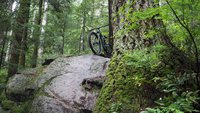
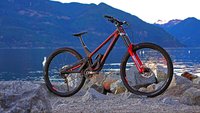

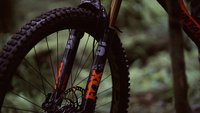







Comments
JT
3 years, 3 months ago
'fast enough to regularly break bike parts, but slow enough to still pay for all of them.'
That there is gonna be the quote to beat this year. Kudos!
Reply
AndyMcRod
3 years, 3 months ago
"...29er game is that wheelbase is now measured in postal codes, and colour coordination is of paramount importance"... made my day!!! :)
Great article. I'm also new in 29er game and also a dual crown forks lover... so I fully share your opinion on all levels!
Reply
RideEverything
3 years, 3 months ago
Great article! Very humourous!
This article and Andrew Major's recent piece (and comments section discussion) on dual crowns have been very timely. I'm in the process of building up a GeoMetrom G1 XXLongest. I'm planning to put a Boxxer lowered to 180mm on it. But, I'm wrestling with all of the unknowns of running a "trail bike" with a DC fork.
I'm a big guy (199cm, 113kg rtr/ 6'6", 250lbs) so I think I'll definitely benefit from a stiffer fork. I'd also like to think that I'm a relatively aggressive rider and the DC fork will help with that as well.
Thanks for adding to what little info is out there on running a DC fork on a pedal bike!
Reply
Perry Schebel
3 years, 3 months ago
almost 100lbs on me; i imagine any SC would feel bendy under you.
dc forks make lots of sense in the world of long(er) travel, near-dh ready aggressive trail bikes. fattening sc fork stantions are one thing, but the achilles heel is still that crown-steerer interface. much more nerding out tuning potential with dc's as well (ride height, custom offsets), as well as the extra negative air spring volume to play with. something like mojo's MORC 36 (fox 36 dc conversion kit) would be pretty rad.
Reply
RNAYEL
3 years, 3 months ago
@RideEverything, a friend of mine just built up the same bike as you in the same size. He put a Formula Nero R, lowered to 180mm, at the recommendation of the folks at Geometron and it's working very well for him. He trail rides the bike, no not park.
Reply
Ryan Walters
3 years, 3 months ago
For me, the biggest hurdle was price - none of the other typical concerns (weight, steering radius, looks, etc.) were a factor. For that reason, the Boxxer was the obvious choice.
I think that if money were no object, I might have looked at Ohlins. I've heard a lot of very good things about their latest dual crown offerings.
Reply
fartymarty
3 years, 3 months ago
@RideEverything Please post some photos when done as I would love to see it built up.
Reply
RideEverything
3 years, 3 months ago
I cannibalized my Boxxer from my 29er DH bike. That's helping with some of my build costs. I'm also planning to use the DH wheelset for Bike Park duties and running a second wheelset for everything else.
I think my biggest worry is turning radius with a DC fork. However, for all the times I've ridden in the WBP behind my slow moving class which has forced me into some entertainingly tight tech lines and I've ended up managing that so my worries are probably unfounded. I've never ridden a DC fork outside of the park so it's a total unknown. There's only one switchback corner on a trail in the Whistler valley (Darwins) that comes to mind when thinking about turning radius with a DC fork.
I definitely get flex out of SC forks. I have a 36 and a Lyrik and can see the fore/aft flex sometimes when braking hard. I'll admit that I don't really notice too much torsional flex on those forks. It only gets highlighted when I've chosen the absolutely wrong-est line and I need to wrench the bike out of it.
It is good to hear from others that a DC fork out on a trail ride is no problem. I am looking forward to the double takes when I'm up at the top of Lord of the Squirrels with DC fork!
My plan is to run my G1 as my almost "One Bike". I have an HT as well.
Reply
Garrett Thibault
3 years, 3 months ago
I had a Boxxer on my Kona Steely because I needed a fork with a long, straight 1 1/8 steertube to fit the huge headtube on that frame. I ran it that way for a year at 140mm and my tight radius corner experience was similar to Ryan’s. I sometimes did use the bump stop, but it was rare. I don’t think I ever failed to make a corner because of it.
Reply
Ryan Walters
3 years, 3 months ago
Yeah, the bump stops are totally a non-issue. Even with the fat Norco head tube area, it never stopped me from making an awkward turn. A steel frame would have even more clearance.
I suppose you may have trouble if you frequently ride extremely tight, uphill switchbacks.
Reply
neilBar
1 year, 10 months ago
@rideeverything - Well, Chris, “ Mr. Geometron” and Marcel the ace CAD man at Geometron HQ both generally run dual crowns. Last I saw him Chris was still on the reduced offset (MORC) 40, Marcel - the customised dual crown (MORC) 36 they make.
Reply
flatch
3 years, 3 months ago
Yes yes yes! I swapped out my Lyric for a 180mm Boxxer deluxe on my Meta and won’t look back. Stiffer and quieter, win win.
Reply
Mitch Stockwell
3 years, 3 months ago
Since I've never ridden a Dual Crown, what makes them quieter? Or are you just referring to creaky CSUs?
Reply
Ryan Walters
3 years, 3 months ago
Creaky CSU's.
Reply
flatch
3 years, 3 months ago
Creaky. Can’t tolerate that, especially when it’s right under your nose. Aside from warranty there doesn’t seem to be a lot a guy can do about it.
Reply
fartymarty
3 years, 3 months ago
Ryan - great article. Your Range looks so good with the boxxer. I'm sure we will see more of this in the next few years. If money were no object* I would run a dropped Ö 38.
*and I had bigger hills
Reply
kram12345
3 years, 3 months ago
I just switched from a single crown to dual crown on a large G1 and it’s great. Downside? People looking at you weird for having a DH fork when I ride easy trails with my kids. I also stuffed a 29” into a 27.5 boxxer and its tight but works fine for me, your mileage may vary. The reason I went that way is a 29 boxxer set to 180 has the same a/c as a 27.5 boxxer set at 200(Very close anyway and I get more squish). the Nero was a fork I was seriously looking at because up to this point I always ran manitou forks(which are fantastic) and the Nero has something very similar to manitou’s irt. Midstroke support is the only area where the boxxer seems to lack. Does anybody have any experience with the formula Nero r? It’s impossible to find any recent information on it.
Reply
Cam McRae
3 years, 3 months ago
People looking at you weird can also be considered an upside!
Reply
RNAYEL
3 years, 3 months ago
This comment has been removed.
RNAYEL
3 years, 3 months ago
Kram PM me and I can put you in touch with a friend that recently mounted one on his G1.
Reply
Jakub Gábriš
3 years, 3 months ago
If you want more mid stroke you can get 3rd chamber tuning for boxxer as well? Like AWK?
Reply
Ryan Walters
3 years, 3 months ago
While mid-stroke support is definitely not the greatest on the Boxxer, I found that running a fair amount of LSC along with "many" tokens got me pretty close to where I wanted the fork.
If I was still running it, I might have been inclined to check out one of the aftermarket ramp-up cartridges like the ones from MRP or AWK
Reply
Morgan Heater
3 years, 3 months ago
I'm pretty surprised that more Enduro pros aren't doing this. Seems like they'd need the precision and support and the insane speeds they operate at.
Reply
Ryan Walters
3 years, 3 months ago
I suspect there are several reasons to this. In enduro racing, rider fatigue is a big deal. The point can definitely be made that a stiffer dual crown is likely to contribute to fatigue over a long day of riding and racing. Although my own experience tells me that the handlebar likely has more to do with hand and arm fatigue than the number of fork crowns.
Also, factory pros are going to be less concerned about the life expectancy of their CSU's. I'm sure the data is very hard to come by, but it would be really interesting to know how many CSU's a pro enduro racer goes through in a season.
Reply
fartymarty
3 years, 3 months ago
Also the majority are sponsored by Fox / RS who have just released 38/Zebs. Running a cut down Boxxer / 49 would kill long travel single crown forks.
Reply
kram12345
3 years, 3 months ago
This👆🏻. To me (probably less aggressive rider than R Walters) a triple crown is more forgiving because of the added travel I get from the same a/c. To be honest mine is almost too plush compared to the single crown I was running, which is not necessarily a bad thing unless your riding a pump track.
The weight is so close (at least with a boxxer, Nero) to a long travel single crown that it doesn’t matter, turning is a non issue, and I would be a lot less hesitant to buy a used triple as opposed to a used single crown.
Reply
Morgan Heater
3 years, 3 months ago
It seems like if it's actually significantly faster (1%? 2%?) then at least the privateers that weren't as worried about sponsorship would do it.
Reply
Timer
3 years, 3 months ago
Could turning radius play a role there? I don't know enough about pro-level cornering technique, but Enduro tracks frequently feature tight switchbacks while DH race courses usually don't.
Reply
Jakub Gábriš
3 years, 3 months ago
Not really, it´s only when bike physically doesn´t fit into the corner where it becomes a problem regardless of fork.
Reply
Jerry Willows
3 years, 3 months ago
If you really want to nerd out of dual crown vs single:
https://www.vitalmtb.com/features/Single-Crown-vs-Dual-Crown-Which-One-is-the-Best-for-Enduro,2953
tldr:
Uphill: 1000 m climbing (over an hour) = 34 seconds longer at 2 lbs more on dc
Downhill: 14 min dh = 20 seconds faster on dc
more details in the vid/article.
Reply
Ryan Walters
3 years, 3 months ago
Pretty cool the lengths he went to in trying to maintain a fair, impartial test.
Although it did feel like a Manitou advert in some spots, haha!
Reply
Tim Coleman
3 years, 3 months ago
Very interesting, and probably not far off from my guess of what the time differences would be. But Ryan's article really isn't about racing. It's more about his enjoyment of his bike when descending. I can associate.
Reply
DadStillRides
3 years, 3 months ago
Don't think I'll ever be riding a dual crown, but this was a great read. Hope to see more articles from you, Ryan.
Reply
hongeorge
3 years, 3 months ago
"Fork offset went from 42mm on the Lyrik to 46mm on the Boxxer. Pushing the front wheel out a bit would give me more stability and confidence on steep, fast and otherwise fun trails."
Is't it the other way around? That longer offset means less stability (however counterintuitive that might be). And would any of us actually notice?
Reply
Ryan Walters
3 years, 3 months ago
Yeah, I wasn't super clear about my thought process here. More offset does make for less stable (quicker) steering. My thoughts were more about increasing the front-centre of the bike. Pushing the front wheel out a bit would keep me from going over the bars on truly steep and scary stuff - a situation where I find myself regularly. I'm often on trails where the rear wheel is unweighted to the point where it is almost losing contact with the ground. I do feel that the increased offset helped a bit in these situations. I think that the ideal solution would have been to increase the reach along with the front-centre, while keeping offset the same. Of course, this would mean changing the frame itself (which I did end up doing in the end anyway!).
Reply
hongeorge
3 years, 3 months ago
I wonder about the whole offset thing - I mean, the longer offset, as you say, moved the wheel further in front of you, and increases wheelbase - both those things should be increasing stability - In my mind, the wheel further in front is analogous to a slacker head angle.
But then you're told that shorter offset makes the bike more stable.... I wonder if these characteristics don't ultimately cancel each other out.
Reply
neilBar
1 year, 10 months ago
@hongeorge
Interesting and yes that’s what I thought.
Marcel at Geometron HQ did educate me on one aspect of this comparison, though.
A DC fork (to feel the same) needs more offset than an SC (due to less flex).
Reply
Tim Coleman
3 years, 3 months ago
Awesome article! I've been toying with trying a dual crown on my trail bike for eons as well. The Marzocchi Z1 and now 38 have got me most of the way to feel I'm looking for from the front end. Like you mentioned none of them are as stiff and precise as a proper dual crown fork. It'll be interesting to see if the Zeb keeps you happy, or if you start scrolling the Buy/Sell for a 29er Boxxer.
Reply
Sean Chee
3 years, 3 months ago
Yes many times over. As a tall and heavy rider, 36’s feel a lot more flexy to me than your typical compact and svelte enduro bike buyer. I am definitely going to be running DC forks on my next big hit bike, probably a shore or ransom. The forks it comes with will go on my “xc” bike if they’re 29”.
If the industry really was serious about DC the 300gm weight delta between zeb and boxxer could disappear quickly between the DM stem, skinnier HT, and smaller headset parts before you even start to talk about saving weight in the fork itself. If only they decided DC would be the next industry trend...... haha I know I’m dreaming.
Reply
Ryan Walters
3 years, 3 months ago
Absolutely agreed. If the industry got serious about enduro dual crowns, I’m sure the weight could come down to the burly single crown range. Take some of the weight out of the CSU area and put it into the extra crown and stanchions.
Reply
hongeorge
3 years, 3 months ago
This comment has been removed.
cheapondirt
3 years, 3 months ago
Downside: people asking how you like your "triple tree" fork.
I like the maple, but if I'm honest I find cedars a little homely, and the cottonwood dropped a branch way too close to my head last ride.
Reply
bumVSmtn
3 years, 3 months ago
where’s the new SID XL?
Reply
Briain
3 years, 3 months ago
I just put a dorado on my nukeproof mega and I love it. Just couldn't get on with the 36 it came with. The steering feels so much more direct. You do feel the extra weight on the front end but never had any issue with steering lock
Reply
Glass
3 years, 3 months ago
Great article. I have running dual crowns for the last 10 years. I briefly tried a Yari when I could no longer get parts for my much loved Shiver. It was so bad. The flex under braking, the stiction and the constant need to open it up to get it to feel semi decent! I end up getting a Dorado. I weigh 60kg/132lbs but I can still feel a significant difference. The Fox 36 is better than the Lyric/Yari chassis but still no where near the stiffness of a dual crown.
I was rather disappointed that the new 38s (Fox and Rockshox) were not dual crown.
I have noticed that the turning radius of the Boxxer is one of the worst compared to a 40 or a Dorado. I think it is down most of the offset being in the lowers and the stantion tubes being closer together.
My experience is that the benefits of a dual crown outweigh the added weight. The reduced turning radius isn't really a problem on modern bikes because you tend to lean the bike over more in corners than turn the handlebars when going down. On tight switchbacks you can always nose turn (generally faster than skidding around). Going up on really tight stuff can be overcome again by line choice or hopping/pulling the front end around.
Oh and I think the bike just looks way cooler with a dual crown too!
Reply
Sam Lee
3 years, 2 months ago
Nice article, wish there are more stories like yours! I had a fun summer with the Bartlett on my Capra29 but trail riding was compromised here in SE NYS (tight trails). I have a 38 on the way but am wondering if I would be better off with a Z1 coil or 36 converted to coil set at 170-180 travel.
With the DC on it, I don't reach for it much and I feel guilty looking at her in my garage. My last new 36 had the CSU swapped out under warranty too for creaking. If that happens with the 38 I'll fix it and sell it and either stick with the Bartlett or convert the 36 the bike came with to coil a la Smashpot.
Reply
sacha_stingray
2 years, 9 months ago
been running a 2013 fox 40 on my 2014 Nomad v3 forever, it's rad for parks, steeps, chunk. 200mm travel, but you can adjust the head angle by raising or lowering the stanchions in the clamps--i've settled around 63 degrees. apart from my resulting neolithic seat tube angle the geo is quite current!
Reply
jason
3 years, 3 months ago
That “issue” on the north shore rack is a Norco issue. Not an issue because you put a Boxxer on a trail bike. Every Norco DH bike I know has difficulty on an NS rack. You have to bend one of the tines on the rack to make it fit.
The head tube is just that much bigger on Norco bikes making it hard to fit the rack tines in between the fork and head tube.
Reply
Ryan Walters
3 years, 3 months ago
Interesting. The Range had no problems fitting the NSR4 with the Lyrik installed. North Shore Racks did tell me that dual crowns sometimes caused issues depending on the bike.
I can think of a few other trail bikes that must be problematic. The Evil headtubes come to mind.....
Reply
Morgan Heater
3 years, 3 months ago
I have a dedicated "evil" spot on my NS rack for friends with evils. I had to bend two of the tines out a bit, and it works fine. I just can't shuttle with two friends on evils.
Reply
Ryan Walters
3 years, 3 months ago
Hahaha!
Reply
IslandLife
3 years, 3 months ago
This comment has been removed.
Lu Kz
3 years, 3 months ago
It's really not a Norco thing. Just within my riding group we've had North Shore racks play badly with YT's and some Rocky Mountains as well as my Aurum HSP. Add this to Evils the other commenter mentioned and we're starting to compile quite a list!
It was one of the main reasons I swapped my NSR out for a Hangover this past spring. NSR's been behind the times for years at this point.
Reply
Please log in to leave a comment.